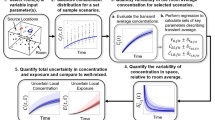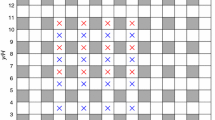Abstract
The ingress of exterior contaminants into buildings is often assessed by treating the building interior as a single well-mixed space. Multizone modelling provides an alternative way of representing buildings that can estimate concentration time series in different internal locations. A state-space approach is adopted to represent the concentration dynamics within multizone buildings. Analysis based on this approach is used to demonstrate that the exposure in every interior location is limited to the exterior exposure in the absence of removal mechanisms. Estimates are also developed for the short term maximum concentration and exposure in a multizone building in response to a step-change in concentration. These have considerable potential for practical use. The analytical development is demonstrated using a simple two-zone building with an inner zone and a range of existing multizone models of residential buildings. Quantitative measures are provided of the standard deviation of concentration and exposure within a range of residential multizone buildings. Ratios of the maximum short term concentrations and exposures to single zone building estimates are also provided for the same buildings.
Similar content being viewed by others
References
Armour T (2011). European study group with industry 80: Analytical solutions for compartmental models of contaminant transport in enclosed spaces. Technical Report, Industrial Mathematics KTN.
Bekö G, Lund T, Nors F, Toftum J, Clausen G (2010). Ventilation rates in the bedrooms of 500 Danish children. Building and Environment, 45: 2289–2295.
Bennett JS (2009). A systems approach to the design of safe-rooms for shelter-in-place. Building Simulation, 2: 41–51.
Casal J, Planas-Cuchi E, Casal J (1999). Sheltering as a measure against airborne virus spread. Journal of Hazardous Materials, 68: 179–189.
Chan WR, Nazaroff WW, Price PN, Gadgil AJ (2007a). Effectiveness of urban shelter-in-place. I: Idealized conditions. Atmospheric Environment, 41: 4962–4976.
Chan WR, Nazaroff WW, Price PN, Gadgil AJ (2007b). Effectiveness of urban shelter-in-place. II: Residential districts. Atmospheric Environment, 41: 7082–7095.
Chan WR, Nazaroff WW, Price PN, Gadgil AJ (2008). Effectiveness of urban shelter-in-place. III: Commercial districts. Building Simulation, 1: 144–157.
Haas A, Weber A, Dorer V, Keilholz W, Pelletret R (2002). COMIS v3.1 simulation environment for multizone air flow and pollutant transport modelling. Energy and Buildings, 34: 873–882.
Howard-Reed C, Nabinger SJ, Emmerich SJ (2008). Characterizing gaseous air cleaner performance in the field. Building and Environment, 43: 368–377.
Jacquez JA (1996). Compartmental Analysis in Biology and Medicine, 3rd edn. Ann Arbor, MI, USA: BioMedware.
Jacquez JA, Simon CP (1993). Qualitative theory of compartmental-systems. SIAM Review, 35: 43–79.
Kaplan H (2009). A model for the toxic dose under time-varying concentration. Journal of Hazardous Materials, 167: 351–356.
Konartit C, Sokhi RS, Burton MA, Ravindra K (2010). Activity pattern and personal exposure to nitrogen dioxide in indoor and outdoor microenvironments. Environment International, 36: 36–45.
Lai ACK (2004). Modeling of airborne particle exposure and effectiveness of engineering control strategies. Building and Environment, 39: 599–610.
van Leeuwen D (1992). Protection against toxic substances by remaining indoors. In: Methods for the Determination of Possible Damage to People and Objects Resulting from Releases of Hazardous Materials CPR 16E (Green Book, Chapter 6). Voorburg, The Netherlands: TNO.
Lim T, Cho J, Kim BS (2011). Predictions and measurements of the stack effect on indoor airborne virus transmission in a high-rise hospital building. Building and Environment, 46: 2413–2424.
Liu X, Zhai ZJ (2009). Prompt tracking of indoor airborne contaminant source location with probability-based inverse multi-zone modeling. Building and Environment, 44: 1135–1143.
Miller RS (2011). Elevator shaft pressurization for smoke control in tall buildings: The Seattle approach. Building and Environment, 46: 2247–2254.
Montoya MI, Planas E, Casal J (2009). A comparative analysis of mathematical models for relating indoor and outdoor toxic gas concentrations in accidental releases. Journal of Loss Prevention in the Process Industries, 22: 381–391.
Parker S, Coffey C (2011). Analytical solutions for exposures and toxic loads in well-mixed shelters in support of shelter-in-place assessments. Journal of Hazardous Materials, 192: 419–422.
Parker ST, Bowman VE (2011). State-space methods for calculating concentration dynamics in multizone buildings. Building and Environment, 46: 1567–1577.
Persily A, Musser A, Leber D (2006). A collection of homes to represent the U.S. housing stock. Technical Report, NISTIR 7330, National Institute of Standards and Technology.
Persily A, Davis H, Emmerich SJ, Dols WS (2009). Airtightness evaluation of shelter-in-place spaces for protection against airborne chemical and biological releases. Technical Report, NISTIR 7546, National Institute of Standards and Technology.
Singer BC, Hodgson AT, Destaillats H, Hotchi T, Revzan KL, Sextro RG (2005). Indoor sorption of surrogates for sarin and related nerve agents. Environmental Science and Technology, 39: 3203–3214.
Singer BC, Hodgson AT, Hotchi T, Ming KY, Sextro RG, Wood EE, Brown NJ (2007). Sorption of organic gases in residential rooms. Atmospheric Environment, 41: 3251–3265.
Sohn MD, Apte MG, Sextro RG, Lai ACK (2007). Predicting size-resolved particle behavior in multizone buildings. Atmospheric Environment, 41: 1473–1482.
Sorensen JH, Shumpert BL, Vogt BM (2004). Planning for protective action decision making: Evacuate or shelter-in-place. Journal of Hazardous Materials, 109: 1–11.
Ten Berge W, Zwart A, Appelman L (1986). Concentration-time mortality response relationship of irritant and systemically acting vapours and gases. Journal of Hazardous Materials, 13: 301–309.
Walton GN, Dols WS (2010). CONTAMW user guide and program documentation. Technical Report, NISTIR 7251, National Institute of Standards and Technology.
Author information
Authors and Affiliations
Corresponding author
Additional information
Published with permission of the Defence Science and Technology Laboratory on behalf of the Controller of HMSO.
Rights and permissions
About this article
Cite this article
Parker, S., Coffey, C., Gravesen, J. et al. Contaminant ingress into multizone buildings: An analytical state-space approach. Build. Simul. 7, 57–71 (2014). https://doi.org/10.1007/s12273-013-0136-5
Received:
Revised:
Accepted:
Published:
Issue Date:
DOI: https://doi.org/10.1007/s12273-013-0136-5




